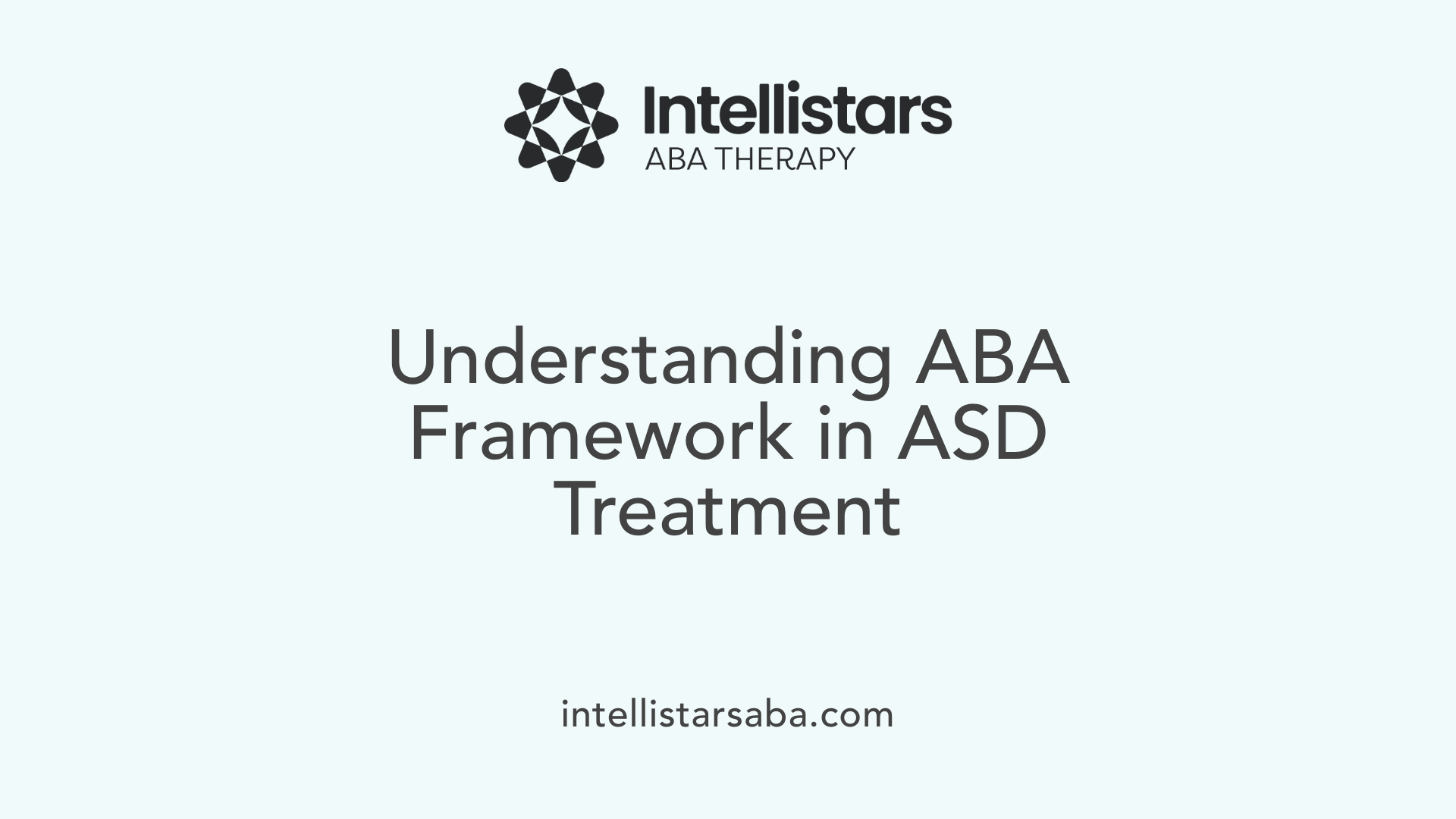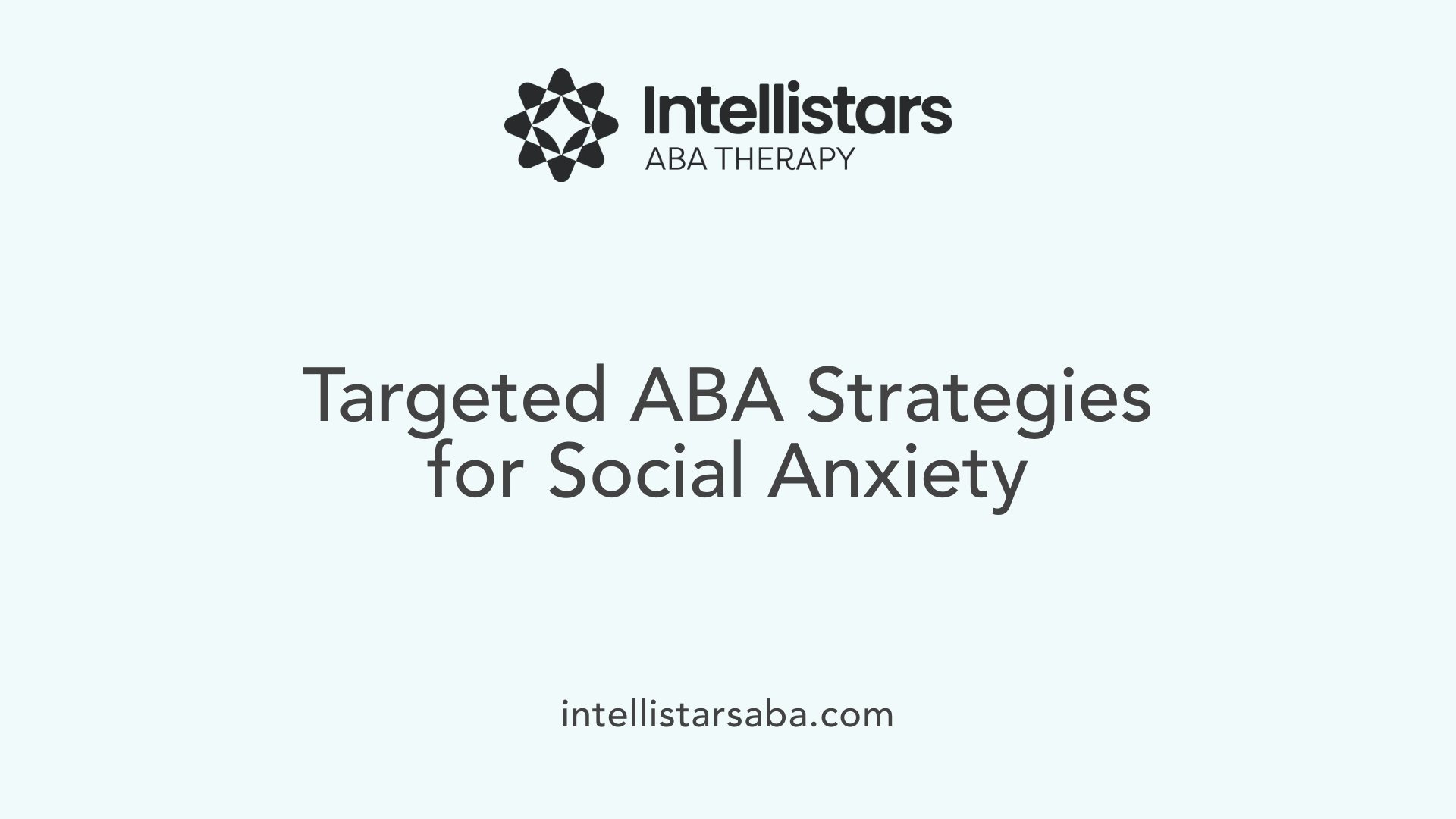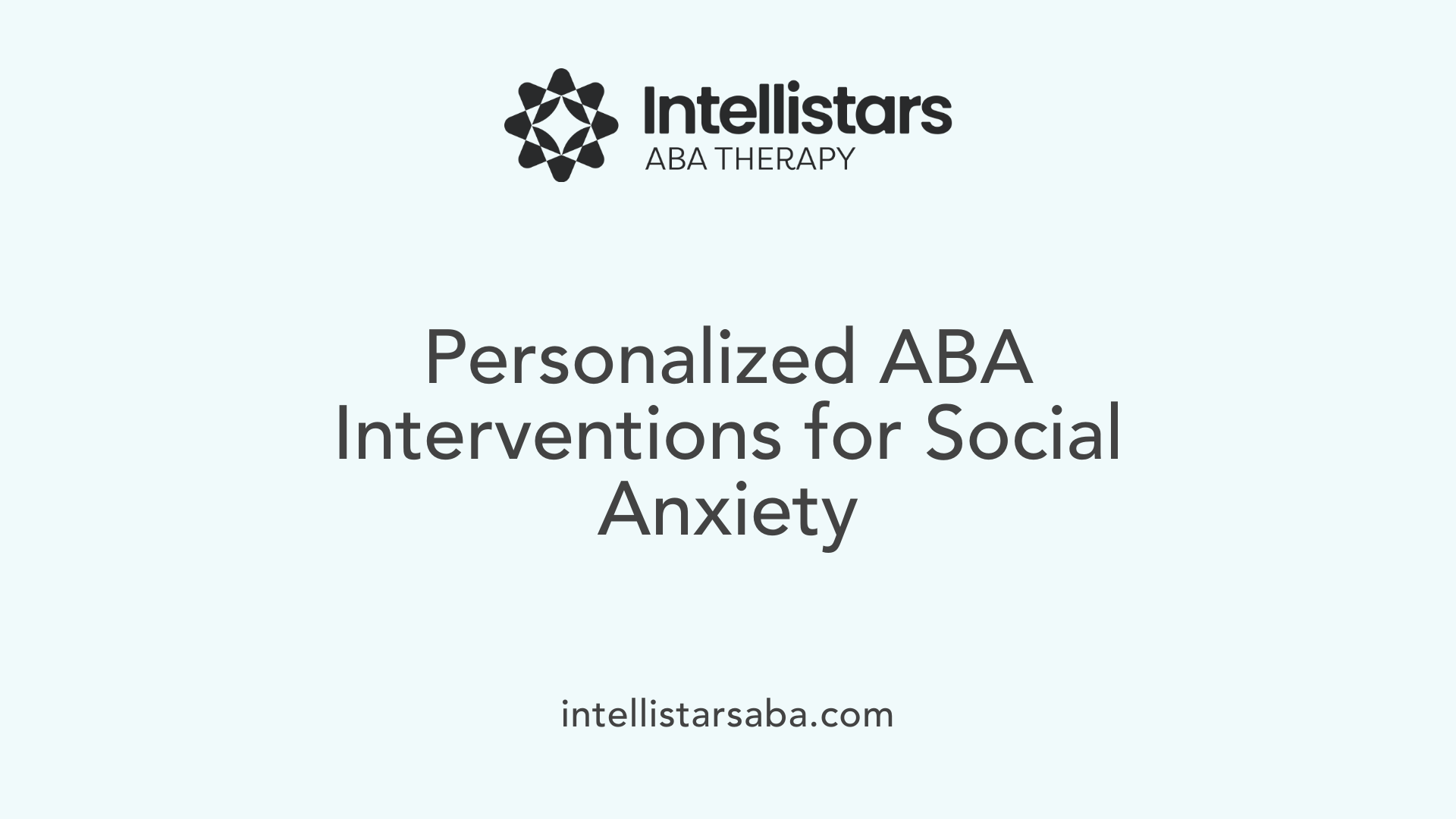Understanding How ABA Addresses Social Anxiety in Children with Autism
Social anxiety can significantly impact the lives of children with autism, limiting their ability to engage in meaningful social interactions and fostering feelings of isolation. Applied Behavior Analysis (ABA), a widely used behavioral intervention, plays a pivotal role in reducing social anxiety symptoms while enhancing social skills. This article explores how ABA therapy functions as a comprehensive approach to help children with autism gain confidence, improve social understanding, and foster emotional regulation.
The Framework of ABA and Its Application in Autism Spectrum Disorder

Overview of ABA therapy principles
Applied Behavior Analysis (ABA) is a widely recognized behavioral treatment for children with autism spectrum disorder (ASD). Its core principle involves using structured techniques grounded in behavioral science to encourage desirable behaviors and reduce undesired ones. ABA focuses on understanding how environmental factors influence actions and utilizes reinforcement strategies to promote learning and skill development.
ABA's approach is individualized, meaning treatment plans are tailored to each child's unique needs. Therapists often break down complex skills into smaller, manageable steps and apply consistent reinforcement to encourage practice and mastery. The ultimate goal is to help children gain independence, improve social skills, and enhance overall functioning.
Use of behavioral analysis to promote desired behaviors
Behavioral analysis in ABA involves systematically observing behaviors and identifying the antecedents (what happens before a behavior) and consequences (what happens after). By analyzing these patterns, therapists can modify the environment to increase positive behaviors and decrease problematic ones.
Reinforcement plays a crucial role in this process. For example, when a child initiates a conversation or completes a task, they receive a reward—such as praise or a preferred activity—to encourage repeated behavior. Desensitization and gradual exposure are also used to help children become more comfortable with anxiety-provoking stimuli, thereby reducing anxiety symptoms.
Common ABA teaching styles, including DTT and PRT
Among the various ABA strategies, two prominent teaching styles stand out:
| Teaching Style | Description | Typical Use | |---------------------------|--------------|--------------------------------------------------------------| | Discrete Trial Training | Uses structured, step-by-step instructions | Teaching specific skills like language or self-care | | Pivotal Response Training | Focuses on pivotal behaviors like motivation and response to multiple cues | Enhancing social initiation and communication |
Discrete Trial Training (DTT) employs a highly structured approach where each trial involves clear instructions, prompts, and immediate reinforcement. It effectively teaches specific skills through repetition and reinforcement.
Pivotal Response Training (PRT), on the other hand, occurs in more naturalistic settings. It aims to improve behaviors that impact broad areas of development, such as motivation and social responsiveness, by rewarding pivotal behaviors. PRT focuses on making learning engaging and relevant to the child's interests, increasing the likelihood of generalizing skills across settings.
How does ABA therapy help reduce social anxiety in children with autism?
ABA therapy helps reduce social anxiety in children with autism by explicitly teaching and reinforcing crucial social skills. These include initiating conversations, understanding social cues, maintaining eye contact, and responding appropriately in social interactions.
Therapists use tailored programs that incorporate role-playing, video modeling, and gradual social exposure. Positive reinforcement encourages children to practice these skills, boosting confidence in social settings. Relaxation techniques, desensitization, and emotional regulation strategies are integrated to help children manage anxiety-provoking stimuli.
Moreover, group sessions create safe environments for peer interactions, enabling children to develop social competence without feeling overwhelmed. This systematic and personalized approach addresses both skill deficits and emotional regulation, leading to reduced social fears and improved social functioning.
Teaching Social and Emotional Skills Through ABA
What benefits does ABA therapy provide for improving social skills and reducing anxiety in children with autism?
Applied Behavior Analysis (ABA) offers substantial advantages in helping children with autism develop social skills and manage anxiety more effectively. By applying principles of behavior analysis, ABA teaches children to interpret social cues, understand body language, and engage in appropriate social interactions.
One of the core techniques used in ABA therapy for this purpose includes role-playing, where children practice real-life social scenarios in a supportive environment. Video modeling is another effective tool, allowing children to observe and imitate positive social behaviors shown in videos. These methods help children rehearse social skills, build confidence, and internalize expected social responses.
Positive reinforcement plays a crucial role in encouraging desired social behaviors. When a child demonstrates appropriate social interaction, they receive praise or rewards, motivating continued use of those behaviors. Prompting strategies, such as verbal cues or physical guidance, support children in initiating conversations, sharing, and taking turns.
Moreover, ABA addresses social anxiety by gradually exposing children to challenging social settings in a controlled manner. This gradual approach includes teaching relaxation techniques and coping mechanisms, helping children develop resilience and reduce feelings of anxiety associated with social interactions.
A significant benefit of ABA is its individualized focus. Each child's learning plan is tailored to target specific social deficits and anxiety-related issues. Goals are measurable and broken down into manageable steps, ensuring consistent progress.
Research shows that these personalized strategies lead to improvements in communication, relationship-building, and overall social functioning. Children often experience increased independence and confidence, with reduced anxiety levels as they become more comfortable navigating social environments.
In summary, ABA therapy not only equips children with autism to build vital social skills but also helps alleviate associated anxieties, fostering emotional well-being and social integration. Through structured techniques like role-playing, video modeling, reinforcement, and prompting, ABA creates a supportive pathway toward more meaningful social interactions.
Specific ABA Strategies to Tackle Social Anxiety

What strategies and techniques are used in ABA therapy to address social anxiety in children with autism?
Applied Behavior Analysis (ABA) employs a range of targeted strategies to help children with autism overcome social anxiety. Recognizing that anxiety often hampers social engagement, ABA therapists focus on creating structured, supportive environments where children can learn and practice social skills.
One of the primary techniques is social skills training, which involves direct instruction in social behaviors such as greeting others, sharing, and turn-taking. This is often complemented by role-playing exercises that allow children to rehearse these skills in a safe setting. Simultaneously, behavioral modeling—showing desired behaviors for children to imitate—serves as a visual and practical example of appropriate social interaction.
Gradual exposure plays a crucial role in reducing social fears. Through systematic desensitization, children are gradually introduced to social situations, starting with less intimidating scenarios and progressively moving toward more complex interactions. This graded exposure helps decrease avoidance behaviors, making social settings feel less overwhelming.
Reinforcement strategies are integral to encouraging positive social behaviors. For instance, specific rewards, such as praise or preferred items, are used to reinforce successful social interactions, thus increasing the likelihood of these behaviors occurring again.
Incorporating visual aids like social stories, picture schedules, and cue cards further supports children in understanding social expectations and cues. These visual tools make abstract social concepts more concrete and accessible.
Family involvement is vital in ensuring the generalization of skills and the consistency of interventions. Training parents and caregivers to implement ABA strategies at home helps reinforce learning and provides children with additional opportunities to practice skills across different settings.
Overall, ABA combines prompting, reinforcement, systematic desensitization, and visual supports within a data-driven framework. This holistic approach not only teaches children new social skills but also enhances their confidence and reduces anxiety during social interactions, enabling better integration into daily life.
Tailored Interventions Within ABA for Social Anxiety

What treatment approaches within ABA therapy specifically target social anxiety in children with autism?
Applied Behavior Analysis (ABA) offers a range of targeted strategies to address social anxiety in children with autism. Central to these approaches are techniques like social narratives and peer modeling.
Social narratives are personalized stories that describe social situations, expected behaviors, and positive outcomes. They help children understand social cues and what is expected of them, reducing uncertainty and fear.
Peer modeling involves children observing and imitating the social behaviors of peers who demonstrate appropriate social skills. This method provides real-life examples and encourages children to practice these skills in a supportive setting.
Structured social routines and exposure exercises are vital components. These involve creating predictable social settings in which children can gradually face and manage anxiety-provoking situations. Incremental exposure, paired with reinforcement such as praise or tokens, builds confidence and decreases avoidance behaviors.
Teaching relaxation and self-regulation techniques is also significant. Children learn methods like deep breathing, mindfulness, and positive self-talk, which help them manage feelings of anxiety during social interactions.
Additionally, ABA incorporates role-playing exercises that simulate real-life social scenarios. Children practice initiating conversations, maintaining eye contact, and understanding social cues through step-by-step guidance tailored to their individual needs.
The overarching goal of ABA intervention is to systematically reduce social anxiety while promoting engagement and social competence. By combining reinforcement, modeling, exposure, and relaxation strategies, ABA therapy helps children develop healthier social behaviors and more positive social experiences.
How do these ABA strategies work together to improve social skills and reduce anxiety?
Many of the techniques used in ABA are interconnected. For example, social narratives prepare children for upcoming social situations, making exposure exercises less intimidating. Peer modeling provides practical examples, which reinforce what they've learned through narratives.
Relaxation techniques equip children with tools to manage their anxiety physically and emotionally, facilitating better participation during social routines or exposure activities. Role-playing brings together these methods, allowing children to practice skills in a controlled environment with support.
The personalized nature of ABA ensures that interventions target each child's specific anxieties and social deficits. As children become more confident, their avoidance behaviors decrease, and their social engagement increases.
Through consistent application of these strategies, ABA creates a supportive learning environment where children gradually overcome social fears and develop meaningful connections, ultimately leading to a decrease in overall anxiety levels.
Evaluating the Effectiveness of ABA in Alleviating Social Anxiety

How effective is ABA therapy in managing social anxiety symptoms among children with autism?
Applied Behavior Analysis (ABA) has established itself as a cornerstone in the behavioral treatment of children with autism spectrum disorder (ASD). Its focus on reinforcing desired behaviors and reducing undesired ones makes it particularly suitable for addressing social challenges and anxiety symptoms.
Research supports the positive impact of ABA on reducing social anxiety and enhancing social skills. Techniques like modeling, behavioral reinforcement, and social stories enable children to learn appropriate social responses and navigate social contexts more comfortably. Personalizing ABA strategies to meet each child's unique needs further boosts effectiveness, highlighting the importance of tailored intervention plans.
Recent studies suggest that combining ABA approaches with adaptations similar to cognitive behavioral therapy (CBT) can yield even better outcomes. For instance, integrating CBT elements such as emotional regulation and mindfulness into ABA sessions has shown promise in increasing treatment response and improving social functioning. Children receiving customized ABA interventions often exhibit significant progress in managing anxiety symptoms and engaging more confidently in social interactions.
Early intervention plays a crucial role in maximizing these benefits. When ABA therapy is introduced at a young age, and with active collaboration between therapists and parents, the results tend to be more substantial. This approach helps children develop foundational social and coping skills early, reducing the severity of social anxiety over time.
Moreover, combining ABA with other therapies, such as social skills training and parent-mediated interventions, further enhances treatment outcomes. Such comprehensive strategies ensure that children are supported across different environments, fostering generalization and maintenance of learned behaviors.
In summary, evidence indicates that ABA therapy, especially when personalized and introduced early, is highly effective in managing social anxiety symptoms among children with autism. Its structured yet adaptable nature makes it a valuable tool in helping children develop the social competencies necessary for a more connected and less anxious social life.
Integrating ABA with Broader Autism Support Strategies

Combining ABA with CBT and other therapies
Applied Behavior Analysis (ABA) and Cognitive Behavioral Therapy (CBT) are among the most supported interventions for children with autism spectrum disorder (ASD). While ABA focuses on teaching desired behaviors through structured reinforcement and reducing undesired behaviors, CBT is tailored to address specific emotional and anxiety issues that many children with ASD face.
Research shows that integrating these therapies can offer a comprehensive approach. For instance, a modular CBT program adapted for children with ASD and comorbid anxiety has demonstrated significant success, with nearly 79% of children showing positive treatment response. When combined with ABA techniques such as desensitization, social skills training, and emotional regulation, children benefit from a holistic intervention plan.
Addressing sensory sensitivities concurrently
Many children with ASD experience sensory sensitivities that can exacerbate anxiety and interfere with learning new coping strategies. Combining therapies effectively involves addressing these sensitivities at the same time as behavioral and emotional skills development.
In practice, ABA strategies like structured environments and behavioral modeling help mitigate sensory overload by creating predictable settings and teaching appropriate responses. Additionally, sensory integration techniques can be incorporated into therapy sessions to gradually desensitize children to specific stimuli, thus reducing overall anxiety.
Ensuring comprehensive, multidisciplinary support
A well-rounded autism support plan involves coordination among professionals from various disciplines, including behavioral therapists, psychologists, occupational therapists, and educators. This multidisciplinary approach ensures that all aspects of a child's development, including social skills, adaptive functioning, sensory processing, and emotional well-being, are addressed.
Implementing integrated strategies can help children with ASD improve their adaptive behavior, manage anxiety, and develop essential life skills. Tailoring interventions to meet individual needs increases the likelihood of sustained positive outcomes.
Overview of autism support strategies
| Strategy | Focus Area | Approach Details | Additional Notes |
|---|---|---|---|
| ABA Therapy | Behavior and skills development | Discrete trial training (DTT), pivotal response training (PRT) | Widely used, emphasizes reinforcement of desired behaviors |
| CBT | Emotional regulation and anxiety management | Modular, adapted programs for ASD and anxiety | Improves diagnostic outcomes, maintains gains over time |
| Sensory Integration | Sensory sensitivities | Desensitization, sensory diets | Reduces overload, improves comfort and focus |
| Multidisciplinary Support | Overall developmental and behavioral health | Coordinated intervention plans | Ensures comprehensive and individualized care |
Together, these approaches form a versatile framework to support children with ASD, enabling them to navigate their world with greater confidence and improved functioning.
Long-Term Outcomes and Benefits of ABA in Social Anxiety Treatment
Maintaining Gains at Follow-Up Assessments
Applied Behavior Analysis (ABA) therapy has demonstrated significant long-term benefits for children with autism spectrum disorder (ASD) and anxiety disorders. Studies show that children who undergo ABA interventions retain their improvements in anxiety management and adaptive behaviors months after treatment concludes. Follow-up assessments, typically conducted around three months post-therapy, reveal that many children continue to show reduced levels of anxiety and increased social functioning.
These sustained benefits are attributed to the structured nature of ABA, which teaches enduring coping skills and behavioral routines. The use of reinforcement and gradual exposure within ABA helps solidify positive behaviors and emotional responses, making them more resilient over time.
Enhancing Independence and Social Integration
ABA strategies are instrumental in fostering greater independence among children with ASD. By focusing on pivotal skills such as initiating communication, sharing attention, and social responsiveness, ABA enhances children’s ability to navigate social situations effectively.
Through targeted interventions like Pivotal Response Training (PRT), children learn to engage more naturally in social environments, which boosts their confidence and promotes social integration. Schools and community settings often incorporate ABA techniques to support children’s ongoing social development, helping them participate more fully in peer interactions and daily activities.
This increase in independence and social skills not only improves the child's quality of life but also reduces social anxiety, making new environments less intimidating.
Supporting Emotional Regulation and Resilience
An essential aspect of long-term success with ABA is its role in teaching emotional regulation and resilience. Children learn to recognize their emotional states, employ mindfulness techniques, and utilize behavioral strategies to manage anxiety episodes.
For instance, emotional regulation training within ABA involves teaching children to identify feelings of anxiety early and apply coping mechanisms, such as deep breathing, sensory calming strategies, or social stories. These skills enable children to handle stressful situations more adaptively.
Resilience is further fostered through consistent practice and positive reinforcement of adaptive responses. Over time, children become more equipped to face challenges independently, which fosters confidence and reduces the likelihood of anxiety recurrence.
Overall Impact and Future Directions
The cumulative evidence underscores that integrating ABA with tailored interventions like cognitive-behavioral therapy (CBT) can produce durable improvements in managing anxiety and enhancing functional independence. These benefits extend beyond immediate symptom relief, laying a foundation for lifelong skills.
Ongoing research continues to explore how combining these approaches and customizing strategies based on individual needs can maximize long-term outcomes. The emphasis remains on developing resilient, socially skilled individuals capable of navigating complex environments with reduced anxiety.
| Aspect | Description | Supporting Evidence |
|---|---|---|
| Long-term retention | Sustained symptom reduction and adaptive behaviors over months | Follow-up studies show persistent benefits |
| Social skills development | Improved social engagement and peer interactions | PRT and social skills training within ABA applications |
| Emotional regulation | Ability to manage anxiety and emotional responses | Mindfulness, coping strategies learned in ABA |
| Independence | Increased autonomy in daily routines and social settings | Transition programs and community-based ABA interventions |
| Resilience building | Enhanced capacity to cope with future stressors | Reinforcement of adaptive responses in therapy |
By fostering these developments, ABA therapy proves itself as a foundational component in addressing long-term challenges associated with ASD and anxiety, helping children lead more fulfilling, socially integrated lives.
Summary: Why ABA Therapy is a Key Component in Reducing Social Anxiety
Overall Benefits of ABA in Social Skills and Anxiety Reduction
Applied Behavior Analysis (ABA) therapy is a widely used approach for children with Autism Spectrum Disorder (ASD) that aims to improve social skills and reduce anxiety symptoms. This behavioral method encourages desired actions and discourages undesired behaviors, creating a structured environment conducive to learning. It employs techniques like desensitization, social skills training, and emotional regulation to help children handle social situations better.
Research shows that children undergoing ABA therapy often exhibit significant improvements not just in their social interactions but also in managing anxiety. By teaching coping strategies such as mindfulness and emotional regulation, ABA helps children gain confidence and reduce fears associated with unpredictable social settings.
Personalized and Systematic Approach
One of the strengths of ABA is its tailored nature. The therapy is customized to meet each child's unique needs, making it highly effective. For example, two common ABA teaching styles are discrete trial training (DTT) and pivotal response training (PRT). DTT involves structured, step-by-step learning with immediate rewards, ideal for teaching specific skills.
On the other hand, PRT occurs in everyday settings and aims to develop pivotal behaviors like initiating communication or engaging socially. These techniques facilitate natural social interactions and adaptive behaviors.
ABA strategies also include creating structured, predictable environments that help reduce anxiety. By establishing routines and using behavioral modeling, ABA helps children feel more secure and capable of navigating social and emotional challenges.
Empirical Evidence of Success
Numerous studies underpin ABA's effectiveness. In particular, research highlights that ABA can significantly lessen anxiety symptoms while fostering social and adaptive skills.
For instance, children with ASD participating in ABA programs often demonstrate increased social initiations and improved emotional regulation. These benefits are supported by data showing that ABA interventions lead to lasting changes, with improvements maintained well after treatment completion.
Research also confirms that ABA therapies, such as desensitization and social skills training, are instrumental in helping children overcome fears related to social interactions. These positive outcomes are evident across various settings, including schools and clinics.
In conclusion, ABA therapy plays a crucial role in managing social anxiety among children with ASD. Its evidence-based, personalized approach enables children to develop essential social skills and emotional resilience, paving the way for more successful and less anxious social experiences.
Empowering Children with Autism to Thrive Socially
ABA therapy offers a powerful, evidence-based approach to reducing social anxiety and improving social competence in children with autism. Through its individualized, systematic strategies—ranging from social skills training and reinforcement to relaxation techniques and gradual exposure—ABA not only helps children develop confidence but also fosters greater independence and emotional resilience. When integrated with other therapeutic modalities and delivered early and consistently, ABA serves as a cornerstone in supporting children with autism to achieve meaningful, lasting social engagement and quality of life.
References
- Cognitive behavioral therapy for anxiety in children with autism ...
- Leveraging ABA Therapy for Anxiety - Flywheel Centers
- Treatment and Intervention for Autism Spectrum Disorder - CDC
- Cognitive behavioral therapy for anxiety in children with autism ...
- ABA Therapy for Social Anxiety in Autism
- Social Anxiety in Individuals with Autism Spectrum Disorder
- How ABA Therapy Enhances Social Skills in Children with ASD
- Can ABA Therapy Help with Anxiety? In Many Cases, Yes
- treatment of anxiety in individuals with autism spectrum disorders






